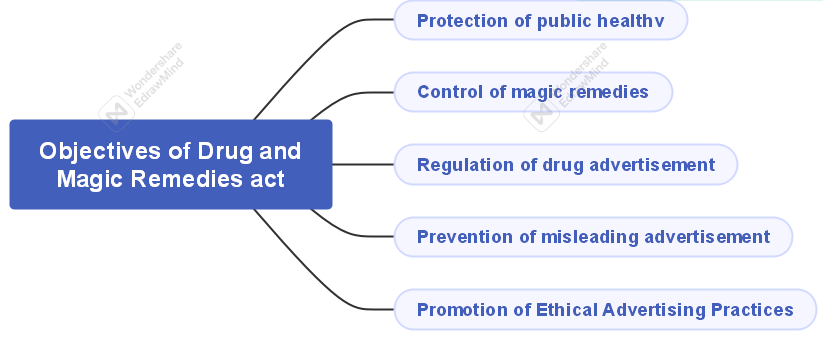Table of Contents
The Drug and Magic Remedies act (1954)
The Drug and Magic Remedies Act of 1954 assumes a pivotal role in upholding transparency within the pharmaceutical sector. It establishes stringent guidelines to prohibit the dissemination of misleading claims or false advertisements pertaining to drugs and magical remedies.
Objective
The primary objective of the act is to protect the health and well-being of consumers by preventing deception or misinformation that could lead them to acquire products that are ineffective or potentially harmful. Basically, it controls certain type of ad’s relating to drug. It is used to prohibit certain kind of ads relating to magic remedies which makes false claim and are likely to mislead public. These are some main objectives:
- Prevention of misleading advertisement
- Protection of public health
- Regulation of drug advertisement
- Control of magic remedies
- Promotion of Ethical Advertising Practices
- Monitoring and Enforcement
- Adaptation to Technological Advances
Definitions of some points
1. Advertisement
It includes all notices circular labelled rappers or other documents and all announcement made orally or by means of producing or transmitting light or sound or smoke.
2. Drug
Drug is a chemical substance which is used to the prevention, treatment & diagnosis and cure to disease. It’s also used externally and internally. In the other word, any substance intended to be used in the diagnosis cure, prevention, treatment of any disease in the human & animals.
3. Magic remedies
It includes talisman, mantras, kavach or any other charm of any kind which is alleged to possess miraculous power for in the diagnosis, mitigation, prevention & diagnosis in the human and animals.
Prohibit advertisement under this act magic remedies (1955)
1. For the procurement of miscarriage or prevention of conception in women.
2. For the correction of menstrual disorder in women.
3. For the maintenance or improvement of the capacity of human beings for sexual pleasures.
4. Diagnosis, cure, treatment, mitigation, prevention in human beings specified in schedule J act 1940.
5. Advertisement which are directly or indirectly gives false impression regarding true character of drug.
6. Making of false claim of drug.
7. Advertisement related to magic remedies claiming their efficacy for any of conditions out lined by person whose purpose is to carry on the profession of magic remedies.
Advertisement whose import & export inhibit
Import and export of all documents containing ads of nature referred about is completely prohibited. Any documents containing any such ads are deemed to be goods of import or export has been prohibited under the sea customs act 1878.
Exempted ad
Sign boards or notices displayed by registered practitioners that indicating that treatment is undertaken for treatment of disease or disorder.

Books or treatises relating to the disease or ailments published from bonafide scientific or social standing. Ads sent confidentiality in a prescribed manner to regard medical practitioner however such ads should follow ads:
1. Any ads relating to a drug printing or published by the government or any person with the prior permission of government.
2. Ads level or set of instructions which are permitted under drug and cosmetic act under 1940.
Ads exempted conditionally
Leaflets or literature accompanying packing of a drug. Ads of drugs in medicinal pharmaceutical scientific or officials’ journals.
Disease which can’t be cure under drug and cosmetic act 1940
These are some disease names:
1. Angina pectoris
2. Appendix
3. Blindness
4. Bronchial asthma
5. Cancer
6. Growth & change of colour of hair
7. Diabetes
8. heart disease
9. Disorder of uterus
10. Fatus
11. Fairness of skin


